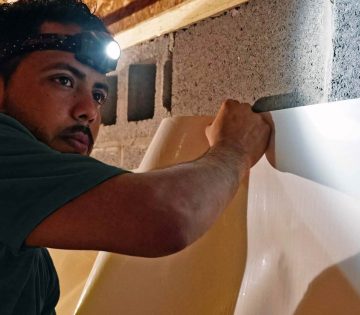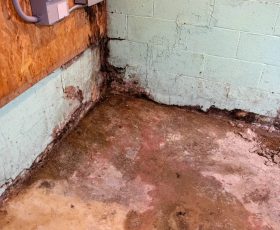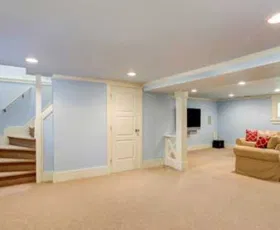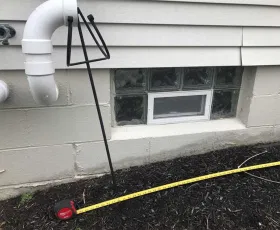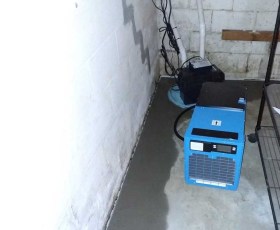Problem Signs
Basement water problems are pervasive. Whether you live in a generally humid area, a generally arid area, or somewhere in between, chances are that you’ve had basement water problems of some kind at some point. A wet basement is a huge problem, and there are many other issues that can arise because of these basement water problems.
JES Foundation Repair

Musty Basement Smell
Dampness, cracks, and waterproofing issues can cause serious basement moisture problems, which can themselves lead to mold and other health concerns.
JES Foundation Repair

Wet Drywall in Your Basement
Wet drywall typically comes around because of cracks in your walls and general leaking.
JES Foundation Repair

Basement Condensation
No homeowner wants to deal with basement condensation. Learn more about the signs and solutions to protect your home.
JES Foundation Repair

Wet Basement Carpet
Fixing problems associated with dampness, cracks, and flooding is not always easy, and you can’t always fix it on your own.
Don’t see your water problem?
VIEW MORE BASEMENT WATERPROOFING PROBLEM SIGNS >
Causes
There are numerous reasons your house may have these problems. Most of these causes stem from the ground.
A footing drain is installed just outside of your home’s basement foundation. This drain is meant to keep water away from your foundation but it can easily clog. The footing drain is thick pipe that has holes drilled into it to allow water to drip into the pipe.
Stone is laid on top of the drain pipe to prevent the backfill from clogging the pipe. Over time the backfill seeps through the stone and clogs the pipe. There’s no way to keep the footing pipe clean unless you want to excavate the ground surrounding your home to flush the pipe. This is incredibly messy, expensive and could damage your foundation. And who wants to do that?
When hurricane season comes around, you need to do more than prepare for the hurricane by buying supplies. You also need to prep your home for the heavy rain and flooding that the storm may bring.
The heavy rain and flooding brought by the hurricane contribute to hydrostatic pressure and soil settlement. Both of which can result in basement wall cracks and a very wet basement. So when hurricane season comes around, make sure to check your sump pump, current waterproofing and have a plan in place to help keep your basement dry. When in doubt, call your local basement waterproofing experts.
A clogged footing drain will not collect any more water. So the water puddles up into the backfill and starts pushing against your home. The weight of the water creates pressure which pushes against your foundation – this is also called hydrostatic pressure.
The hydrostatic pressure pushes the water into the porous concrete and through cracks in the block or mortar. Over time the hydrostatic pressure, soil settlement and seasonal changes can result in basement wall cracks or cracks in the poured concrete.
Just like its summer and fall cousin, the Nor’easter is famous for flooding basements. The heavy rain and flooding caused by Nor’easters adds to hydrostatic pressure and soil settlement problems, both of which can cause basement wall cracks.
A Nor’easter can occur any time of the year but is notorious for occurring during the winter. It’s called a Nor’easter because it travels to the northeast from the south. These storms can cause flooding, hurricane force winds, heavy rain and snow. All of which can spell trouble for your basement.
The backfilled soil around your basement foundation will settle. As the soil settles it will sink towards your foundation, creating a slope which allows water to run next to your basement foundation, eventually causing hydrostatic pressure.
If your gutters don’t point away from your basement foundation then this can add to the soil settlement problem. You can help prevent some of the hydrostatic pressure from soil settlement by adding dirt to the sunken soil.
Solutions
We Fix Wet Basements! We believe that you deserve only the best. All of our basement waterproofing solutions are custom designed for your home.
JES Foundation Repair

Basement Sump Pump
There are numerous reasons why your home’s basement can develop leaks or result in a complete flood.
JES Foundation Repair

BasementGutter™ Interior Drain System
BasementGutter™ Interior Drain Systems are the best basement waterproofing solutions. Keep your home safe and dry with the JES experts.
JES Foundation Repair

Basement Dehumidifier
A basement dehumidifier will help combat humidity issues in order to keep your basement dry and conserve energy.
JES Foundation Repair

Egress Window
An egress window seals out moisture and is designed to dramatically increase the amount of natural light that comes into your basement.
How can JES help me?
LEARN MORE ABOUT OUR BASEMENT WATERPROOFING SOLUTIONS >
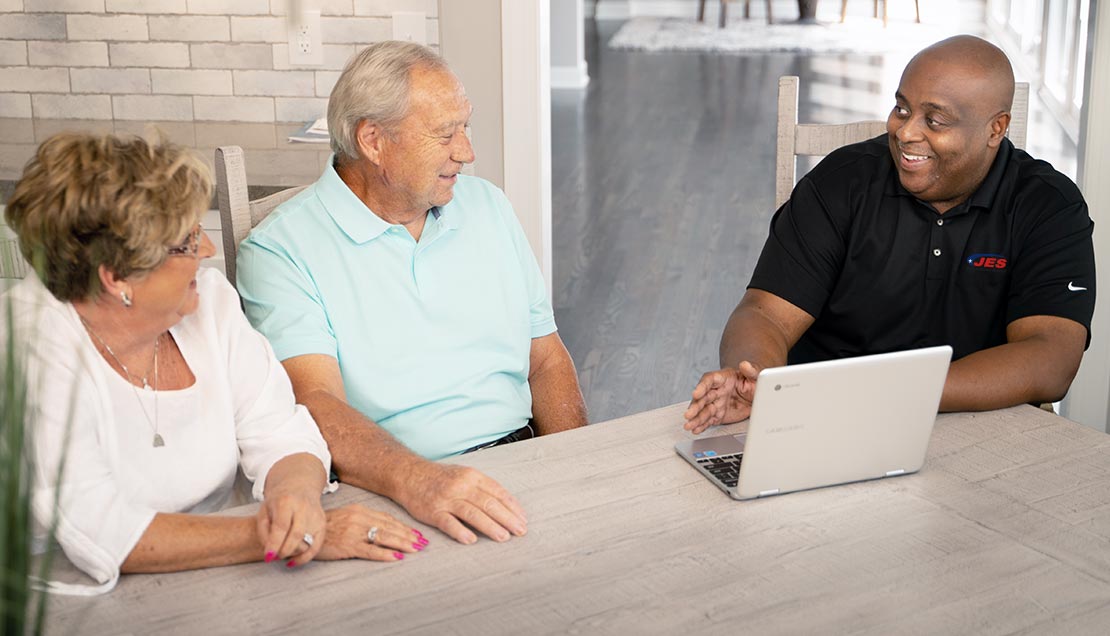
FAQs
It isn’t always a good idea to put your faith in DIY basement repair. For starters, you can’t always be certain as to why you need to repair your wet walls and floor in the first place. You might interpret some natural functions of your basement as signs of danger or dampness, for starters, and overlook the true cause of your home’s damage in the meantime. In doing so, there is a chance that when you try and fix something in your basement on your own, you’ll end up making the problem worse.
If you try to block a leak or otherwise apply a superficial solution to a significant problem, you’re likely to find yourself dealing with even greater damage in the days and weeks to come. Not only that, but should you eventually reach out to a professional for guidance, you may find yourself paying far more for repairs than you anticipated. This is because a professional will have to remove your DIY solution before installing one of their own.
When it comes to fixing your wet drywall, it’s in your best interest to take the process in steps. First, identify your leak. Rapid changes in temperature can cause the pipes to burst, and hydrostatic pressure can build up outside of your home and force cracks to form in your home. Once you’ve identified your leak, you’ll want to reach out to the professionals serving your area to fix it. Should you leave a leak in place, your new drywall will likely find itself wet and unsafe within a week or two of your initial installation. After that, replace your drywall. To replace damaged drywall in your home, you can:
- Measure the hole left in your wall
- Fill the hole with appropriately sized drywall clips
- Secure the clips with drywall screws
- Blend drywall tape and joint compound to smooth out the wall
- Sand the wall until you’re satisfied
After you’ve replaced your drywall and ensured that all other damage to your basement or foundation has been attended to, you can discuss home waterproofing measures with a professional contractor in your area. They will prove most effective for you and will vary based on the circumstances that led to your initial leak. For example, if a pipe burst inside of your home due to dropping temperatures, you may want to invest in a dehumidifier. Alternatively, if it was external flooding that caused humidity levels in your home to rise, you might consider hydrophobic insulation, a vapor barrier, or a sump pump.
Wet drywall can come from a variety of sources, and many people don’t know why their drywall could be wet. Here are a few prominent reasons you might be seeing wet drywall in your home.
Internal Leaks
Internal leaks are one of the more common reasons you could find wet drywall. Do you have a pipe hidden in the wall that’s leaking without your knowledge? Did you recently have a pipe burst in the floor above, causing flooding? Have you noticed that one of your pipe connections is leaking more than normal? These are all sources of internal leaks.
Of all types of leaks, internal ones can sometimes be difficult to fix. When you have a flood in the area, you’ll usually go down to your basement and make sure nothing bad happened. However, if you have a leaky pipe in the bathroom above your basement, you might not realize that it migrated downward. Any time you experience any strange leaks in your home, make sure you check your basement to clear it of leaks as well.
External Leaks
Another possible cause of concern for your home when it comes to wet drywall is leaks from the outside. Did you recently have a flood in the area? Did it rain for a long time after not having any rain at all? Have you noted that water has been pooling around your home’s foundation? All of these sources of external water can cause leaks that will invade the home.
These external leaks are definitely a concern because they’re often responsible for an overly moist basement more so than standing water in the basement. Though you might think standing water is more dangerous than moisture, moisture can still cause foundation problems and mold, and it can be even more difficult to uncover than standing water.
Cracks in Your Walls
If your walls have cracks in them, no matter how tiny, rest assured that water will find a way through those cracks eventually. Water wants to fill any space it enters, and if there’s any way for that space to become larger, the water will follow it. Therefore, it makes sense that water would work through the cracks in your walls.
The problem is, cracks can sometimes be extremely tiny. These cracks, known as “hairline cracks,” can be almost impossible to notice, which can lead to them going unnoticed for a long time, especially if you think a moist basement is normal. If you notice any amount of water seepage in your basement, even if it’s small, you should probably seek help for your basement’s health.
Condensation
Any basement with high levels of moisture will probably deal with condensation at some point. The air can only hold a certain amount of moisture, which people express using the concept of “relative humidity.” When the relative humidity grows over 100%, that extra humidity has to go somewhere. Outside, it turns into rain; inside, it turns into condensation, usually on cool surfaces.
Condensation can be a big problem in your basement because it can provide a fertile breeding ground for mold and mildew. This is especially true when you have drywall because the condensation can form on the drywall and therefore lead to wet drywall even without an internal or external leak. This is just one of the reasons you need to fix your damp basement as soon as possible.
The DIY mindset has made people think fixing things themselves is always possible or preferable to getting an expert. In this situation, that’s not possible, and it’s important to recognize what can arise if you try to do it yourself.
Making the Problem Worse
One of the biggest problems that can arise if you try to fix the problem on your own is unintentionally making the problem worse. Sure, you probably have a variety of YouTube videos and helpful DIY articles that will give you a head start, but do you actually know what you’re doing, or are you just rooting around randomly?
If you make this problem worse, it’s going to be more difficult and more expensive to fix it. You could turn a relatively minor problem into something that might require thousands of dollars and multiple days to fix. Instead, contact a basement waterproofing expert to help you figure out what to do next.
Not Addressing the Real Problem
Another problem that tends to hide under the surface is the problem that you might not actually fix what’s going on. Sure, you might think you’ve fixed the problem, but have you actually? Or, in your quest to fix the problem on your own without really having an understanding of the process, have you instead hidden the true problem?
It’s unfortunately common for a layman to believe that the problem is one thing when it’s actually another. If you think you’ve fixed the problem, watch out, because the problem might be much deeper than that. One of the biggest problems here is that it might make you complacent because you believe the problem is no longer happening, so you’re not going to be on the lookout for any extra problems.
Damaging Something Else in the Process
Although this is less common, it’s still something that can easily happen. What do you do if you’re trying to fix the problem, and in the process, you cause a different and less easy-to-fix problem? For example, you might bring in a ladder to reach a high pipe and in the process knock your ladder onto the wall, breaking free some pieces of concrete and causing a chip in the wall.
These bits of damage aren’t extremely common, but they can happen. If a professional basement waterproofing expert comes to your home and causes damage to another piece of your basement, they’re liable for that damage. If you do it, you’re now liable for the original damage and for the new damage, which can be a very frustrating position to be in.
Investing in a “Cheap Fix”
The allure of a “cheap fix” is something that pulls in many people to DIY fixes. After all, if you can fix your basement water problem without spending a lot of money, why wouldn’t you want to try this fix instead of a much more expensive one from a professional? Of course, the problem with these cheap fixes is that they’re rarely cheap and they’re rarely fixes.
Most often, these cheap fixes are more of a bandage. They help to stem the tide for a little while, but they don’t actually fix anything. Instead, they just put the problem off for anywhere from a few days to a few months. However, when they come back — and they definitely will — you’ll have to spend more money, time and energy to re-install a fix that was never a fix at all.
It is rarely in your best interest to try and apply a DIY solution to a problem with your basement or foundation. The same can be said of your basement cove. Should you try and remove water from your basement cove without assistance, you could find yourself facing a myriad of unexpected problems. Cove joint leakage is especially tricky to take on, as the damage there often appears most obviously beneath your floor.
Unfortunately, if you don’t know what you’re dealing with when you first go to remove water from your basement cove, you’re more likely to find yourself losing money as you work. Similarly, you can often cause more damage to your basement cove when you try and fix the problem therein on your own. Professional contractors, for example, have years of experience working with basement coves and helping homeowners prevent the effects of long-term water damage. If you don’t have that same experience, you may accidentally work with materials that react poorly to long-term exposure to water.
With high basement humidity being the most common problem that causes a rusty water heater, it’s probably good to look into the signs and symptoms of that as well. You may see any of these if you have basement humidity problems.
Wet Carpet
One good indication that your basement is probably humid is whether you have wet carpet. Of course, wet carpet can come from all sorts of sources, both external and internal. You may even end up with wet carpet from condensation coming from other sources of moisture. However, one thing that wet carpet showcases is the fact that there is water somewhere in the basement.
This wet carpet is something you need to get rid of as soon as possible, whether it’s the main source of your basement moisture concerns or not. However, only a basement waterproofing expert will be able to give you more information about your home’s wet carpet, construct a unique plan regarding how to fix it, and institute that plan for you.
Chalky Walls
The strange “chalky” residue you may sometimes see on walls has a name: it’s called efflorescence, and it’s actually salt. When water moves through stone or another structure with salt inside, that water may move the salt to the surface. When it does, it manifests as the chalky or fuzzy residue you may see on your basement walls.
This isn’t harmful on its own. Although some people can mistake it for mold, it’s just hardened salt, and you can scrape it off with a stiff brush with no problem. The issue is not the efflorescence itself, but rather what the efflorescence indicates. When you see it, it means water is moving through your walls, and that’s never a good sign.
Mold and Mildew
Anytime you have a lot of moisture in an area of distinctly nice temperature, as you do with a high-humidity basement, you’re going to end up with a pretty significant amount of mold and mildew in that area. Mold and mildew grow best in areas above around 60% humidity, although it may be able to grow on water-soaked drywall and stone as well.
If you see mold and mildew in your home, regardless of the specific reason for it, you should definitely contact an expert for help. When you notice mold and mildew in your basement, it’s good to contact a basement waterproofing expert, because these are the types of people who are most likely to have the knowledge necessary for fixing it.
Cracked, Leaky Floors
You probably don’t think about water entering your home from the floor because it’s not usually something you think of as having a lot of external pressure. However, because your basement is positioned underground, it’s very likely that your floor experiences the same hydrostatic pressure as the walls, which makes them prone to cracking and leaking.
This is even true if the cracks in your floor aren’t from the hydrostatic pressure itself. Whether you just dropped something very heavy or you ended up with cracks in the floor from the hydrostatic pressure surrounding the floor, any cracks in the floor are a great place for moisture to enter from the outside, which is a significant problem for many homeowners, even if they don’t realize it.
Some people might not see the problem with wet basement carpet at first glance. It can certainly seem unnecessary to treat it with this amount of gravity, for sure. Here are just a few of the problems you might experience.
Mold and Mildew
The first and potentially biggest problem with wet basement carpet is mold and mildew. Whenever you have a wet area, especially a contained wet area, and the right temperature, mold and mildew are sure to exist. Mold and mildew absolutely love wet basements because they are the perfect places for these organisms to grow.
Most of the time, a temperature that is comfortable for humans is also comfortable for mold and mildew. That’s exactly why mold and mildew are so prolific in many basements. If you have wet carpet, chances are you have mold and mildew growing on, around, or under it in some way, and that’s an important thing to get checked out.
Musty Basement Smell
A musty basement smell almost always comes from mold and mildew. It can be tempting to mistake it for a “stale” scent that you might be convinced to “air out.” However, this smell rarely comes from a basement that doesn’t have enough air. Instead, it’s typically that the basement has mold or mildew growing inside.
The best way to get rid of your musty basement smell is to fix the mold and mildew that’s growing on the inside. However, you can’t fix that mold and mildew until you’re able to get down to basics and completely scour the basement to find the cause of your problem. The musty basement smell should be something you check out as soon as possible.
Damp Baseboards
If your basement carpet rests on wooden baseboards, chances are that wet carpet will also extend to wet baseboards. In fact, it’s almost undoubtedly true that you have wet baseboards if you have wet carpet, at least if you let these baseboards sit for too long. You should make sure you’re not allowing your wet carpet to sit because water seepage will transfer the moisture all across the baseboards.
Of course, wet baseboards can have a whole host of issues. Wet baseboards don’t just become a potential host for mold and mildew, but also for wood rot, and wood rot is difficult to treat or eradicate. Wet carpet should itself be enough for you to seek treatment for your basement moisture problems, but if that’s not enough, just think of all the issues wet baseboards can cause.
Signs of a Deeper Problem
The last and potentially most dangerous issue with wet carpet is that it isn’t the only problem. Instead, this wet carpet is just an indication of a much deeper problem. If you ignore the wet carpet or just replace it with a different dry carpet, you’re ignoring the signs that are telling you there’s something much worse going on.
Ignoring these signs will always make the problem get worse. Unfortunately, you can’t just ignore whatever problems you’re experiencing in your home. You have to work toward making those problems better, and the only way you’ll be able to do that in this situation is to bring in a basement waterproofing expert.
The path of fixing water in a basement cove isn’t always easy, and it can be a bit confusing, especially from the outside. The good news is that when you break it down, there are typically four steps, although a basement waterproofing expert may need to do more.
Pump Out Any Standing Water
The first step is simple: If you have any standing water in the basement, you need to pump it out as soon as possible. Standing water in the basement can cause a huge variety of concerns, including but not limited to basement dampness, mold and mildew growth, and even foundation problems if you aren’t able to pump it out properly.
Although this should be the first step, it obviously isn’t the last step. Pumping out standing water is useful because it gets rid of an immediate problem, but that standing water is just a symptom of a deeper problem. What’s next? You need to start looking for that deeper problem.
Find the Source of the Water
Once you’ve pumped out the standing water in your basement, it’s now time to find the source of that water. There are many reasons you could end up with water in your basement cove, but it’s most common to have the water seeping through leaky basement walls. However, that isn’t always the problem; it could be due to a number of issues.
This is one of the reasons you should contact a basement waterproofing expert instead of trying to go in and fix this problem on your own. Often, finding the source of water in your basement cove is a difficult and time-consuming job, and it’s best completed by experts who have spent a lot of time training to do this.
Fix the Source of the Water
After you’ve found the source of the water, you should go through the process of fixing it. Of course, fixing the water source isn’t always easy; it’s possible to have a tough time fixing it. Especially in the case of water in your basement cove, the source of the water might be widespread hairline cracks in your basement wall, which could be an even deeper cause of a number of things.
Again, a basement waterproofing expert is your best bet here. Although there may be a variety of DIY tips and tricks online, a basement waterproofing expert will have all the tools they need to help you uncover the best waterproofing solutions to keep your basement clean and water-free.
Maintain a Clean and Dry Basement
Lastly, once you’ve fixed the initial source of the water and pumped out the water, you’ll need to find a way to maintain that. You might need to use a number of tools to maximize your basement maintenance process. Depending on your unique situation, you might need a dehumidifier or an interior drain system.
However, you can’t just install one of these fixes and call it a day. These fixes need to be tailored to your unique needs, and it’s important that you consider what your basement’s doing if you’re going to install one of these fixes. Only a personalized assessment from a basement waterproofing expert will give you that.
The section where the wall of your basement meets the floor is referred to as the space’s cove joint. These joints have a significant amount of exposure to the groundwater that can put your home’s structural supports at risk. As such, it’s fairly common to see seepage and flooding at these points in your basement. If left untreated for an extended period of time, cove joint leaks can become havens for mold growths. Similarly, leaks in these locations can contribute to the hydrostatic pressure impacting the structural integrity of your foundation, hastening along cracks or sinkage that might lower the overall value of your home.
These joints, however, do not leak at random. If you do not have home waterproofing measures in place, you may find yourself contending with unwanted seepage after every heavy rainstorm. Alternatively, seepage in these areas may suggest damage in your foundation or basement that you’ll need to see right away. The most common causes behind basement cove joint leaks include:
- Hydrostatic pressure
- Foundation shifting
- Leaks, interior and exterior

